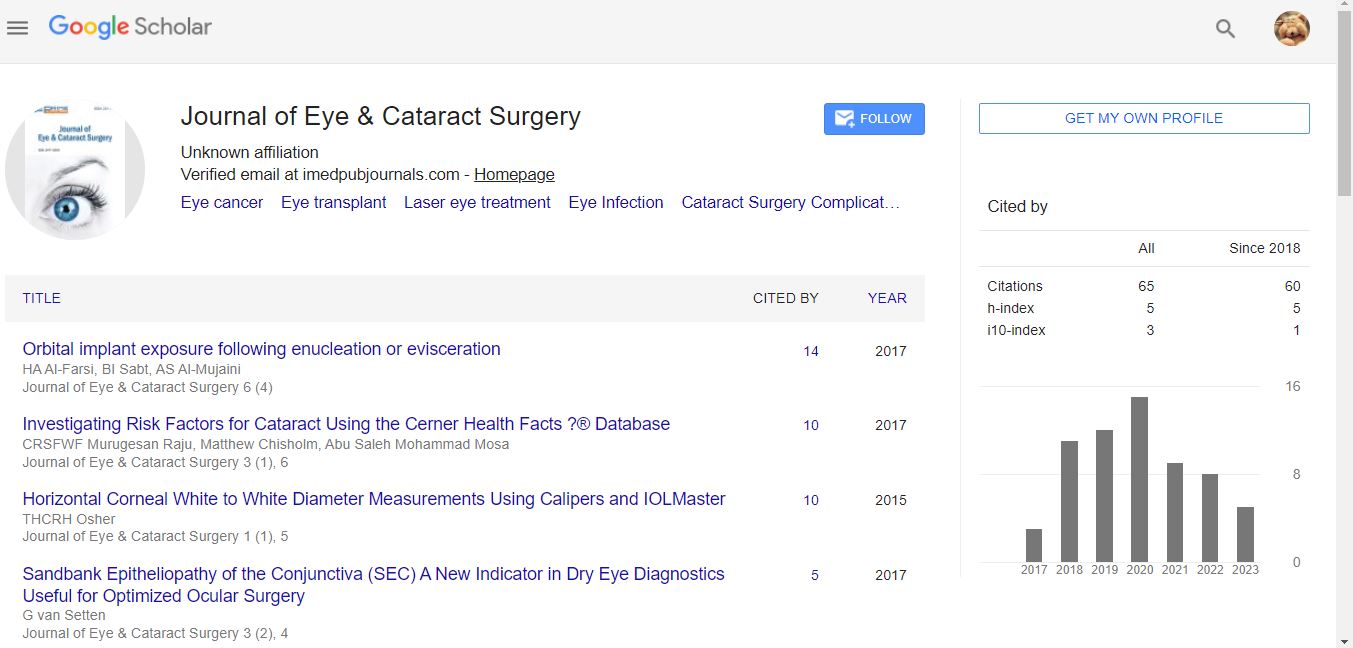Perspective - (2024) Volume 10, Issue 3
Understanding Presbyopia: A Comprehensive Examination of Its Causes and Symptoms,
Dalton Zachary*
Department of Ophthalmology, University of Health and Vision Sciences, USA
*Correspondence:
Dalton Zachary,
Department of Ophthalmology, University of Health and Vision Sciences,
USA,
Email:
Received: 02-Sep-2024, Manuscript No. IPJECS-24-21688;
Editor assigned: 04-Sep-2024, Pre QC No. IPJECS-24-21688 (PQ);
Reviewed: 18-Sep-2024, QC No. IPJECS-24-21688;
Revised: 23-Sep-2024, Manuscript No. IPJECS-24-21688 (R);
Published:
30-Sep-2024, DOI: 10.36648/2471-8300.10.3.28
Introduction
Presbyopia is a common age-related condition characterized by
a gradual decline in the eye’s ability to focus on nearby objects,
typically becoming noticeable in individuals around the age
of 40. This condition results from the natural aging process of
the eye, particularly affecting the lens and its ability to change
shape effectively. As people age, the lens becomes stiffer and
less flexible, making it difficult to adjust focus for close-up
tasks such as reading or sewing. Understanding presbyopia, its
underlying causes, symptoms, and available treatment options
is essential for both patients and eye care professionals. The
most common initial signs include difficulty reading small print,
eye strain or fatigue during close work, and the need to hold
reading materials at arm’s length to see them clearly. Diagnosing
presbyopia typically involves a comprehensive eye examination
conducted by an optometrist or ophthalmologist.
Description
During the exam, the eye care professional will assess visual
acuity using standard eye charts and evaluate how well the
eyes focus on objects at various distances. Additional tests
may be performed to assess the overall health of the eye,
including examinations of the lens, retina, and other ocular
structures. Diagnosis is generally straightforward, as presbyopia
is a well-recognized condition among eye care practitioners.
Once diagnosed, several management strategies are available
to address the symptoms of presbyopia. The most common
treatment option involves the use of reading glasses, which can
help magnify close-up text and improve clarity. For individuals
who require correction for both near and distance vision, bifocal
or progressive lenses may be recommended. Bifocal lenses have
distinct zones for near and distance vision, while progressive
lenses offer a gradual transition between these zones without
visible lines, providing a more natural visual experience. In
addition to traditional glasses, contact lenses are another
viable option for managing presbyopia. Multifocal contact
lenses are designed to provide varying levels of correction for
different distances, similar to progressive glasses. Alternatively,
monovision is a technique in which one eye is corrected for
distance and the other for near vision, allowing for improved
versatility. However, adjusting to contact lenses for presbyopia
may require a period of adaptation, and some individuals may
find it challenging to achieve satisfactory vision. For those seeking
a more permanent solution, surgical options such conductive
keratoplasty may be explored. These procedures, however,
may not be suitable for everyone, and thorough consultations
with eye care professionals are essential to determine the
best approach based on individual needs and circumstances.
In conclusion, presbyopia is a prevalent condition that affects
many individuals as they age, stemming from natural changes in
the eye’s lens and its ability to focus.
Conclusion
While the symptoms can be bothersome, a range of effective
management options exists, including reading glasses, multifocal
lenses, and surgical interventions. Regular eye examinations are
crucial for early detection and appropriate treatment, enabling
individuals to maintain their quality of life and continue engaging
in activities that rely on clear vision. As research and technology
continue to advance, new strategies for managing presbyopia
will likely emerge, providing further hope for those seeking
effective solutions to this common age-related condition. By
fostering awareness and understanding of presbyopia, both
patients and healthcare professionals can work together to
ensure optimal visual health throughout the aging process.
Citation: Zachary D (2024) Understanding Presbyopia: A Comprehensive Examination of its Causes and Symptoms. J Eye Cataract
Surg. 10:28.
Copyright: © 2024 Zachary D. This is an open-access article distributed under the terms of the Creative Commons Attribution
License, which permits unrestricted use, distribution, and reproduction in any medium, provided the original author and source
are credited.

